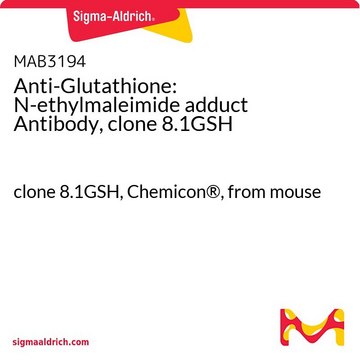E3876
N-Ethylmaleimide
crystalline, ≥98% (HPLC)
Synonym(s):
NEM
About This Item
Recommended Products
biological source
synthetic (organic)
Quality Level
assay
≥98% (HPLC)
form
crystalline
storage condition
(Tightly closed. Dry. Keep in a well-ventilated place. )
technique(s)
activity assay: suitable
co-immunoprecipitation (co-IP): suitable
immunoblotting: suitable
color
white to faint yellow
bp
210 °C (lit.)
mp
43-46 °C (lit.)
solubility
ethanol: 50 mg/mL, clear to slightly hazy, colorless to faint yellow or tan
Looking for similar products? Visit Product Comparison Guide
Application
Biochem/physiol Actions
Preparation Note
Other Notes
Comparable product
signalword
Danger
hcodes
Hazard Classifications
Acute Tox. 2 Oral - Acute Tox. 3 Dermal - Eye Dam. 1 - Skin Corr. 1B - Skin Sens. 1
Storage Class
6.1A - Combustible acute toxic Cat. 1 and 2 / very toxic hazardous materials
wgk_germany
WGK 3
flash_point_f
163.2 °F - closed cup
flash_point_c
72.9 °C - closed cup
ppe
Eyeshields, Faceshields, Gloves, type P3 (EN 143) respirator cartridges
Choose from one of the most recent versions:
Already Own This Product?
Find documentation for the products that you have recently purchased in the Document Library.
Customers Also Viewed
Our team of scientists has experience in all areas of research including Life Science, Material Science, Chemical Synthesis, Chromatography, Analytical and many others.
Contact Technical Service


